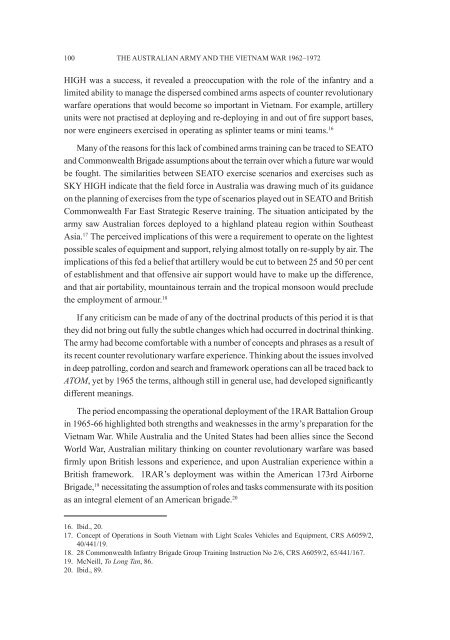conference proceedings - Australian Army
conference proceedings - Australian Army
conference proceedings - Australian Army
Create successful ePaper yourself
Turn your PDF publications into a flip-book with our unique Google optimized e-Paper software.
100<br />
THE AUSTRALIAN ARMY AND THE VIETNAM WAR 1962–1972<br />
HIGH was a success, it revealed a preoccupation with the role of the infantry and a<br />
limited ability to manage the dispersed combined arms aspects of counter revolutionary<br />
warfare operations that would become so important in Vietnam. For example, artillery<br />
units were not practised at deploying and re-deploying in and out of fire support bases,<br />
nor were engineers exercised in operating as splinter teams or mini teams. 16<br />
Many of the reasons for this lack of combined arms training can be traced to seATo<br />
and Commonwealth Brigade assumptions about the terrain over which a future war would<br />
be fought. The similarities between seATo exercise scenarios and exercises such as<br />
SKY HIGH indicate that the field force in Australia was drawing much of its guidance<br />
on the planning of exercises from the type of scenarios played out in seATo and British<br />
Commonwealth Far east strategic reserve training. The situation anticipated by the<br />
army saw <strong>Australian</strong> forces deployed to a highland plateau region within southeast<br />
Asia. 17 The perceived implications of this were a requirement to operate on the lightest<br />
possible scales of equipment and support, relying almost totally on re-supply by air. The<br />
implications of this fed a belief that artillery would be cut to between 25 and 50 per cent<br />
of establishment and that offensive air support would have to make up the difference,<br />
and that air portability, mountainous terrain and the tropical monsoon would preclude<br />
the employment of armour. 18<br />
If any criticism can be made of any of the doctrinal products of this period it is that<br />
they did not bring out fully the subtle changes which had occurred in doctrinal thinking.<br />
The army had become comfortable with a number of concepts and phrases as a result of<br />
its recent counter revolutionary warfare experience. Thinking about the issues involved<br />
in deep patrolling, cordon and search and framework operations can all be traced back to<br />
ATOM, yet by 1965 the terms, although still in general use, had developed significantly<br />
different meanings.<br />
The period encompassing the operational deployment of the 1rAr Battalion Group<br />
in 1965-66 highlighted both strengths and weaknesses in the army’s preparation for the<br />
Vietnam War. While Australia and the united states had been allies since the second<br />
World War, <strong>Australian</strong> military thinking on counter revolutionary warfare was based<br />
firmly upon British lessons and experience, and upon <strong>Australian</strong> experience within a<br />
British framework. 1rAr’s deployment was within the American 173rd Airborne<br />
Brigade, 19 necessitating the assumption of roles and tasks commensurate with its position<br />
as an integral element of an American brigade. 20<br />
16. Ibid., 20.<br />
17. Concept of operations in south Vietnam with Light scales Vehicles and equipment, Crs A6059/2,<br />
40/441/19.<br />
18. 28 Commonwealth Infantry Brigade Group Training Instruction No 2/6, Crs A6059/2, 65/441/167.<br />
19. McNeill, To Long Tan, 86.<br />
20. Ibid., 89.

















